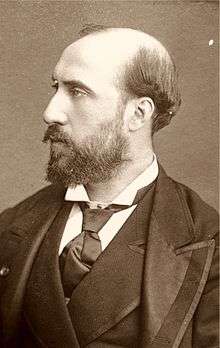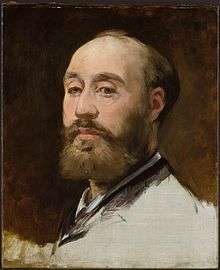Jean-Baptiste Faure


Jean-Baptiste Faure (French: [ʒã.ba'tist foʁ]) (15 January 1830 – 9 November 1914)[1] was a celebrated French operatic baritone and an art collector of great significance. He also composed a number of classical songs.
Singing career
Faure was born in Moulins. A choirboy in his youth, he entered the Paris Conservatory in 1851 and made his operatic debut the following year at the Opéra-Comique, as Pygmalion in Victor Massé's Galathée. He remained at the Opéra-Comique for over seven years, singing baritone roles such as Max in Adolphe Adam's Le chalet and Michel in Thomas's Le caïd. During this time he also created the Marquis d'Erigny in Auber's Manon Lescaut (1856) and Hoël in Meyerbeer's Le pardon de Ploërmel (1859; later known as Dinorah), among seven premieres at that house.[2]
He made his debut at the Royal Opera House, London, in 1860 as Hoël, and at the Paris Opera in 1861. He would sing at the Opera every season until 1869 and then again in 1872-76 and 1878. In addition, he continued to perform off and on in London until 1877 at venues such as Her Majesty's Theatre and the Theatre Royal, Drury Lane.
Among the many operas in which he appeared in Paris were Wolfgang Amadeus Mozart's Don Giovanni as well as L'étoile du nord, Les Huguenots and La favorite.
He also made history by creating several important operatic roles written by such prominent composers as Giacomo Meyerbeer, Giuseppe Verdi and Ambroise Thomas. They included the leading baritone parts in L'Africaine, Don Carlos and Hamlet (in 1865, 1867, and 1868 respectively).
His last stage appearances are recorded as taking place in Marseilles and Vichy in 1886.
Voice
Faure possessed a dark, smooth yet flexible baritone voice, which he used with impeccable skill and taste. He was a sophisticated interpretive artist, too, and all these accomplishments combined to make him one of the most significant figures to have appeared on the French musical stage during the 19th century. He wrote two books on singing, La Voix et le Chant (1886) and Aux Jeunes Chanteurs (1898), and also taught at the Paris Conservatory from 1857 to 1860.
The greatest of Faure's French heirs were the lyric bass Pol Plançon (1851-1914)—who modelled his vocal method directly on that of Faure—and Jean Lassalle (1847-1909), who succeeded Faure as principal baritone at the Paris Opera. Both Plançon and Lassalle made a number of recordings during the early 1900s, and their cultivated performances for the gramophone preserve key elements of Faure's singing style and technique.
Two non-commercial—and possibly unique—brown wax cylinders exist that are thought to be private recordings of Faure singing at around 70 years of age. Though there is no specific documentation of these recordings, one—a rendition of "Jardins de l'Alcazar... Léonor! viens" from Donizetti's La favorite—begins with an announcement (from either the singer or the (Pathé) recording engineer): "Le grand air du baryton!" Pathé and other French recordings from this era nearly always began with an announcement such as "Le sérénade de Don Juan, de Mozart, chanté par [baryton Jean] Lassalle, de l'Opéra!". The affectionate honorific in the supposed Faure cylinder recording only makes sense for a man of advanced years who is so beloved, celebrated, and revered by a general public that he need not even be named. The proliferation of documentation about Faure's standing as such points wholly and only to him. The choice of aria is almost certainly a clue as to the authenticity of the recording, as well. Alphonse of La favorite was one of Faure's most important roles—one with which he toured the provinces of France in 1877, just after his retirement from the stage. He gained enormous critical and popular notoriety from those who hadn't had a chance to hear him in Paris or London. His performances of this role would have left a lasting impression on the public and the press, and the aria was likely chosen for recording as an allusion to that time. A sampling of writing about Faure in this role and specifically this recitative and aria:
His voice is skilled in rendering the most violent as well as the gentlest emotions; and right royal is the way in which he sings the "Jardins de l'Alcazar"[...]— critic, Journal de Bordeaux, March 1877
It was before a house crowded to the ceiling that the celebrated baritone sang the part of Alphonse in a manner thoroughly justifying the brilliant ovation of which he was the object[...] Only those persons who have heard the great artist in La Favorite can have any notion how much Donizetti's music gains in value and charm by such an interpreter. M. Faure is an exceptional singer, possessed of an admirable voice; he is also a first-rate actor. With what authority he sang the grand air of the second act, 'Palais [sic] de l'Alcazar'! What a striking expression of despite and irony he infused into the romance of the third act, 'Pour tant d'amour...'!— critic, Le Progrès, February 12, 1877
Other achievements
In addition, Faure composed several enduring songs, including a "Sancta Maria", "Les Rameaux" ("The Palms") and "Crucifix". (These latter two songs were recorded by Enrico Caruso, among others.) In 1876 he dedicated his valse-légende "Stella" to his sometime leading lady at the Paris Opéra, Gabrielle Krauss.[3]
An avid collector of impressionist art, Faure sat for multiple portraits by Édouard Manet and owned 67 canvases by that painter, including the masterpiece Le déjeuner sur l'herbe and The Fifer. He also owned Le pont d'Argenteuil and 62 other works by Claude Monet. Part of his collection (which also contained paintings by Degas, Sisley, Pissarro, Ingres and Prud'hon) was kept at a villa near Étretat, whose famous cliffs he himself painted.
Faure died of natural causes in Paris in 1914, during the early months of World War I. According to his obituary in the New York Times, he had been made an officer of the Légion d'honneur. He was married to the singer Constance Caroline Lefèbvre (1828-1905).
Roles
This list of known roles contains duplicates where Faure sang in an alternate language. Years indicate the debut of the role into his repertoire.[4]
| Role | Opera | Composer | Year |
|---|---|---|---|
| Amleto | Amleto (Hamlet in Italian) | Ambroise Thomas | 1871 |
| Alfonso D'Este, Duke of Ferrara | Lucrezia Borgia | Gaetano Donizetti | 1876 |
| Alphonse XI, King of Castille | La favorite | Gaetano Donizetti | 1860 |
| Assur | Semiramide | Gioachino Rossini | 1875 |
| Borromée | Marco Spada | Daniel Auber | 1853 |
| Cacico | Il Guarany | Antônio Carlos Gomes | 1872 |
| Charles VII | Jeanne d'Arc | Auguste Mermet | 1872 |
| Crèvecœur | Quentin Durward | François-Auguste Gevaert | 1858 |
| Don Giovanni | Don Giovanni | Wolfgang Amadeus Mozart | 1861 |
| Don Juan | Don Juan (Don Giovanni in French) | Wolfgang Amadeus Mozart | 1866 |
| Dulcamara | L'elisir d'amore | Gaetano Donizetti | 1864 |
| Falstaff | Le songe d'une nuit d'été | Ambroise Thomas | 1854 |
| Fernando | La gazza ladra | Gioachino Rossini | 1860 |
| Figaro | Le nozze di Figaro | Wolfgang Amadeus Mozart | 1866 |
| Gaspard | Der Freischütz | Carl Maria von Weber | 1872 |
| Guillaume Tell | Guillaume Tell | Gioachino Rossini | 1861 |
| Hamlet | Hamlet | Ambroise Thomas | 1868 |
| Hoël | Le pardon de Ploërmel | Giacomo Meyerbeer | 1859 |
| Hoël | Dinorah (Le pardon de Ploërmel in Italian) | Giacomo Meyerbeer | 1860 |
| Iago | Otello | Gioachino Rossini | 1870 |
| Il conte di Nevers | Gli Ugonotti (Les Huguenots in Italian) | Giacomo Meyerbeer | 1876 |
| Julien de Médicis | Pierre de Médicis | Józef Michal Poniatowski | 1861 |
| Justin | Le chien du jardinier | Albert Grisar | 1855 |
| Le Comte de Nevers | Les Huguenots | Giacomo Meyerbeer | 1863 |
| Le duc de Greenwich | Jenny Bell | Daniel Auber | 1855 |
| Le Marquis d'Hérigny | Manon Lescaut | Daniel Auber | 1856 |
| Lotario | Mignon | Ambroise Thomas | 1870 |
| Lysandre | Joconde ou Les coureurs d'aventures | Nicolas Isouard | 1857 |
| Malipieri | Haydée | Daniel Auber | 1853 |
| Max | Le chalet | Adolphe Adam | 1853 |
| Méphistophélès | Faust | Charles Gounod | 1863 |
| Michel | Le caïd | Adolphe Adam | 1852 |
| Nélusko | L'Africaine | Giacomo Meyerbeer | 1865 |
| Paddock | La coupe du roi de Thulé | Eugène Diaz | 1873 |
| Pedro | La mule de Pedro | Victor Massé | 1863 |
| Peters Michaeloff (Peter the Great) | L'étoile du nord | Giacomo Meyerbeer | 1854 |
| Pharaon | Moïse et Pharaon | Gioachino Rossini | 1863 |
| Pietro | La stella del nord (L'étoile du nord in Italian) | Giacomo Meyerbeer | 1864 |
| Pietro | La muette de Portici | Daniel Auber | 1863 |
| Pietro | Masaniello (La muette de Portici in Italian) | Daniel Auber | 1853 |
| Pietro Manelli | La Tonelli | Ambroise Thomas | 1853 |
| Polus | La fiancée de Corinthe | Jules Duprato | 1867 |
| Pygmalion | Galathée | Victor Massé | 1852 |
| Riccardo | I puritani | Vincenzo Bellini | 1863 |
| Rodolfo | La sonnambula | Vincenzo Bellini | 1864 |
| Rodrigue, Marquis of Posa | Don Carlos | Giuseppe Verdi | 1867 |
| St. Bris | Gli Ugonotti (Les Huguenots in Italian) | Giacomo Meyerbeer | 1860 |
| Torrida | Marco Spada | Daniel Auber | 1854 |
| Valbreuse | Le sylphe | Louis Clapisson | 1856 |
References
- ↑ Baker, Theodore; rev. by Nicolas Slonimsky (1994) The Concise Edition of Baker's Biographical Dictionary of Musicians; 8th ed. New York: Schirmer Books, p. 289.
- ↑ Soubies, A. & Malherbe, C. Histoire de l'Opéra comique; La seconde salle Favart 1840–1887. Flammarion, Paris, 1893.
- ↑ "Stella (Faure, Jean-Baptiste)". imslp.org.
- ↑ De Curzon, Henri. "Jean-Baptiste Faure" (translated by Theodore Baker), The Musical Quarterly, Vol IV, No. 2 (April 1918), pp. 271–281 (at the Internet Archive). New York: Schirmer Books.
External links
| Wikimedia Commons has media related to Jean-Baptiste Faure. |
- Works by or about Jean-Baptiste Faure at Internet Archive
- Portraits of Faure at Gallica
- "Jean B. Faure, Singer, Dies at 84,". New York Times. 1914-11-11. Retrieved 2008-08-08., November 11, 1914.
- Free scores by Jean-Baptiste Faure at the International Music Score Library Project
- Free scores by Jean-Baptiste Faure in the Choral Public Domain Library (ChoralWiki)
- Sheet music for Les Rameaux
- Sheet music for Crucifix